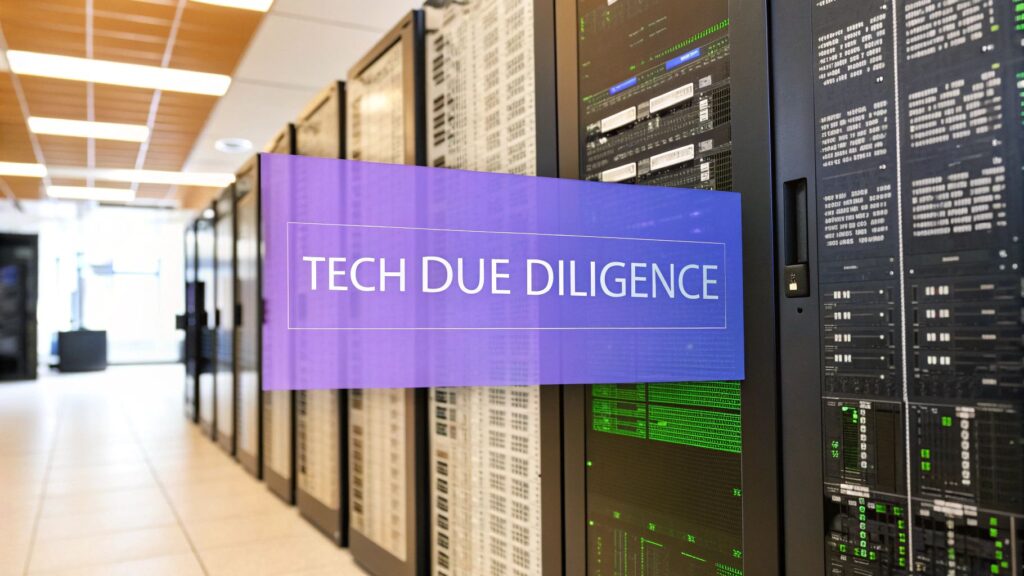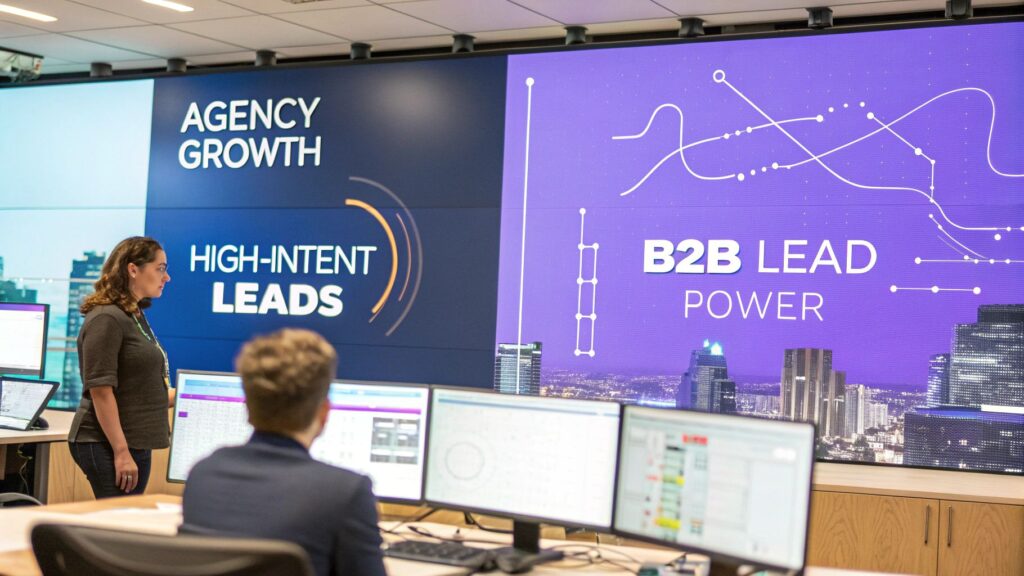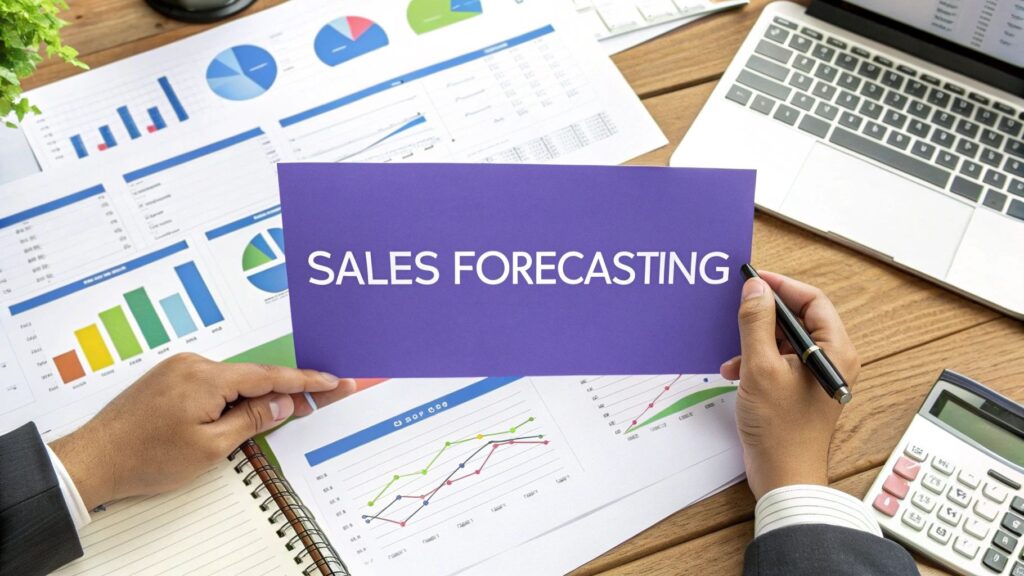Tech Due Diligence Checklist: Key Areas for 2025

- 1. Codebase Architecture and Quality Assessment
- 2. Infrastructure and Scalability Review
- 3. Security and Compliance Audit
- 4. Intellectual Property and Licensing Analysis
- 5. Technology Team and Talent Assessment
- 6. Product and Technology Roadmap Evaluation
- 7. Third-Party Integrations and Dependencies
- 8. Data Architecture and Management
- Tech Due Diligence: 8 Key Areas Compared
- Turning Insights into a Smarter Acquisition Strategy
In any high-stakes merger or acquisition, the financial statements tell only part of the story. The true value, and hidden risk, of a technology company often lies buried within its source code, infrastructure, and the expertise of its team. A superficial glance can lead to catastrophic post-acquisition surprises, from crippling technical debt and unscalable architecture to major security vulnerabilities that can erode value overnight.
A rigorous technical audit is no longer optional; it is the most critical step in safeguarding an investment and ensuring the asset you acquire can actually deliver on its promise. A 2019 report by West Monroe Partners found that nearly half of all M&A deals experience significant, unforeseen technology issues post-close, impacting everything from integration timelines to expected ROI. This guide is designed to prevent that.
We are providing a comprehensive, 8-point tech due diligence checklist to move beyond the balance sheet. This listicle is structured to uncover the real state of the technology, identify potential liabilities, and give you the confidence to make a truly informed decision. We will move beyond theory, offering practical insights, real-world examples, and specific red flags to watch for in each critical area, including:
- Codebase Architecture and Quality
- Infrastructure and Scalability
- Security and Compliance
- Intellectual Property (IP) and Licensing
- The Technology Team and Key Talent
- Product and Technology Roadmap
- Third-Party Integrations and Dependencies
- Data Architecture and Management
This checklist provides the framework to assess whether you are acquiring a robust, scalable asset or inheriting a portfolio of hidden problems.
1. Codebase Architecture and Quality Assessment
A deep dive into the codebase is a non-negotiable first step in any comprehensive tech due diligence checklist. This assessment moves beyond surface-level functionality to evaluate the software's structural integrity, code quality, and accumulated technical debt. It reveals the true state of the technology foundation, providing critical insights into future maintenance costs, scalability potential, and the engineering team's overall discipline and velocity.
Think of it as the difference between a home inspection that only looks at the paint and one that examines the foundation, plumbing, and electrical systems. A solid architecture ensures the product can evolve and scale efficiently, while poor quality can lead to a cascade of bugs, security vulnerabilities, and slow development cycles. This analysis was crucial in Salesforce's $27.7 billion purchase of Slack, where understanding the real-time messaging infrastructure and its ability to handle millions of concurrent users was key to valuing the asset.
Key Metrics for Codebase Health
To quantify the state of a codebase, assessors focus on several core metrics. The infographic below highlights three critical indicators that provide a quick snapshot of engineering quality and potential future challenges.
These metrics collectively signal the codebase's maintainability and the discipline of the engineering team. A high technical debt percentage combined with low test coverage, for instance, is a significant red flag for any potential acquirer. For example, a codebase with 15% technical debt and only 40% test coverage suggests that future development will likely be 15-20% slower and significantly more expensive due to bug fixing and refactoring.
Practical Steps for Assessment
A thorough codebase review combines automated analysis with human expertise. Start by using static analysis tools like SonarQube or CodeClimate to get a baseline on complexity, duplication, and potential bugs.
- Review Commit History: Analyze recent commit logs in Git or SVN to understand development velocity, bug-fix frequency, and contribution patterns. A practical insight: look for a healthy ratio of new feature commits to bug-fix commits (e.g., 70/30). A ratio skewed heavily towards bug fixes can indicate underlying quality issues.
- Examine Testing Strategy: The quality of a product is often directly related to its testing culture. Investigating the company's use of automated testing tools can reveal its commitment to reliability and efficiency. A robust suite of automated tests suggests a mature development process.
- Interview Key Engineers: Talk to senior developers and architects. Ask them about the most challenging parts of the codebase, known technical debt, and architectural decisions they would change. A good question to ask is, "If you had a month to refactor any part of the system, what would it be and why?" The answer is often very revealing.
- Focus on Critical Modules: If time is limited, prioritize the business-critical components of the application. A flaw in the payment processing module is far more significant than one in a rarely used administrative feature.
This video provides further context on the importance of architectural decisions in software development.
2. Infrastructure and Scalability Review
A thorough examination of the technology infrastructure is a cornerstone of any tech due diligence checklist. This process scrutinizes the system's operational backbone, including servers, cloud services, databases, networking, and DevOps practices. It's about understanding if the technology can reliably support the business today and, more importantly, if it can handle significant future growth without collapsing or incurring exponential costs.
Think of it as assessing the factory that produces the product. Even with a perfect product design (the code), a poorly equipped or inefficient factory (the infrastructure) will fail to meet demand, leading to downtime, lost revenue, and a poor customer experience. This analysis was central to Microsoft's $26.2 billion acquisition of LinkedIn, where understanding the infrastructure supporting over 500 million users was critical to justifying the valuation and planning the integration.

Key Metrics for Infrastructure Health
Evaluating infrastructure goes beyond just listing cloud providers. Assessors look for quantifiable evidence of resilience, efficiency, and preparedness. The infographic below outlines three pivotal metrics that offer a clear view of operational maturity and potential risks.
These metrics provide a snapshot of the system's ability to withstand stress and recover from failure. A low Mean Time To Recovery (MTTR), for example, signals a mature incident response process. Top-performing teams often have an MTTR of under one hour, while average performers can take several hours, directly impacting customer trust and revenue.
Practical Steps for Assessment
A comprehensive infrastructure review involves analyzing documentation, financial data, and system configurations. The goal is to uncover hidden costs, single points of failure, and operational bottlenecks.
- Review Recent Outage Reports: Request and analyze post-mortems for any significant outages in the last 12-24 months. These documents reveal root causes, response times, and the effectiveness of the team's problem-solving processes. A practical insight: check if the "action items" from past incidents were actually implemented.
- Analyze Infrastructure Costs: Scrutinize cloud and hosting bills (e.g., from AWS, Azure, GCP) for the past two years. Look for trends, unexpected spikes, and the cost per active user. This helps identify over-provisioned resources or inefficient architecture choices. For a SaaS company, cloud spend should ideally be below 10-15% of revenue.
- Examine Scaling Policies: Investigate auto-scaling configurations and their trigger points. Have they been tested under load? A practical example is asking if the system can handle a sudden 3x traffic spike, such as from a major press mention, without manual intervention.
- Verify Disaster Recovery and Backup Plans: Don't just read the plan; ask for evidence of its last test and the outcome (e.g., logs from a recovery drill). A theoretical disaster recovery plan that has never been executed is a major operational risk.
This video from a Google Cloud expert explains the core principles of building scalable and resilient system architectures.
3. Security and Compliance Audit
A security and compliance audit is an essential component of any tech due diligence checklist, serving as a critical evaluation of a company's ability to protect its data, systems, and reputation. This process goes beyond merely checking for firewalls; it scrutinizes everything from data encryption and access controls to incident response plans and adherence to legal frameworks. A failure here can expose an acquirer to catastrophic financial and reputational damage post-acquisition.
The consequences of overlooking this step are severe. Verizon’s acquisition of Yahoo famously suffered a $350 million price reduction after the discovery of massive data breaches that occurred pre-acquisition but were only revealed during the deal. Similarly, the breach discovered at Starwood after its acquisition by Marriott resulted in a massive £99 million GDPR fine. These cases underscore that a target company's security posture is a direct and material financial risk.
Key Metrics for Security Posture
Evaluating a company's security and compliance health requires a focus on specific, measurable areas. The infographic below highlights three fundamental indicators that offer a clear view of an organization's security maturity and potential regulatory risks.

These metrics provide a concrete basis for assessing risk. A high number of unresolved critical vulnerabilities (e.g., from a recent OWASP ZAP or Nessus scan), coupled with a lack of formal compliance certifications, signals a reactive and immature security program that could harbor significant hidden liabilities.
Practical Steps for Assessment
A comprehensive security audit involves gathering evidence, verifying claims, and testing defenses. It requires a combination of documentation review and technical validation.
- Review Audits and Penetration Tests: Request all recent third-party security audit reports, penetration test results, and vulnerability scan reports. Pay close attention to the severity of findings and the speed at which they were remediated. A practical insight: check the "time to patch" for critical vulnerabilities. Industry best practice is under 30 days.
- Verify Compliance Certifications: Don't just take their word for it. Independently verify the status of any claimed certifications like SOC 2, ISO 27001, HIPAA, or PCI-DSS. A critical component of any security and compliance audit is ensuring adherence to industry standards; for a comprehensive guide, consider this complete SOC 2 compliance checklist for SaaS startups.
- Examine Incident Response: Review the security incident log for the past 24 months. Assess the documented process for handling breaches, the response times, and the post-mortem analyses. For example, did the team meet regulatory notification timelines during their last incident?
- Assess Data Governance: Investigate data retention and deletion policies to ensure they align with regulations like GDPR. How is sensitive customer data classified, stored, encrypted, and ultimately destroyed? Ask for a data map to visualize this flow.
- Evaluate Third-Party Risk: A company is only as secure as its weakest vendor. Review the process for vetting third-party suppliers and the security requirements included in their contracts. For instance, do they require their vendors to also be SOC 2 compliant?
This multi-faceted approach ensures a holistic understanding of the target's security hygiene, which is particularly vital for startups aiming to build a resilient foundation. Exploring cybersecurity strategies for startups can offer further insights into establishing these crucial practices from the ground up.
4. Intellectual Property and Licensing Analysis
Verifying ownership of technology assets is a cornerstone of any tech due diligence checklist. This analysis scrutinizes intellectual property (IP) rights, patent portfolios, open-source compliance, and third-party software licenses. It confirms that the company legally owns or has the right to use its core technology, safeguarding the acquirer from devastating legal liabilities and ensuring the asset's value is not built on a foundation of infringement.
Think of it as checking the title deed before buying a house. Without clear ownership, the entire investment is at risk. A failure in this area can lead to costly litigation, forced code rewrites, or even the invalidation of a core product. This was a central issue in the infamous Oracle v. Google lawsuit over Java APIs in Android, which involved a decade of litigation and billions of dollars in potential damages, reinforcing the need for meticulous IP review.
Key Areas for IP and License Scrutiny
To conduct a thorough review, assessors must dissect the company's technology stack and legal agreements. This involves identifying all components, understanding their origins, and verifying the licenses governing their use. The goal is to create a complete inventory of IP assets and their associated obligations.
This scrutiny uncovers potential "copyleft" license contamination, patent infringement risks, and ownership gaps. Unaddressed issues can significantly devalue a company or even derail an acquisition, as they represent unknown future costs and legal battles. For example, finding a critical algorithm was written by a contractor without an IP assignment agreement could halt a deal entirely.
Practical Steps for Assessment
A robust IP analysis combines automated scanning with meticulous legal and technical review. The process must be systematic to ensure no stone is left unturned.
- Scan for Open-Source Components: Use automated tools like Black Duck or Snyk to scan the entire codebase for open-source libraries. This creates a Software Bill of Materials (SBOM) that identifies each component and its associated license.
- Review License Compliance: Pay special attention to "viral" or "copyleft" licenses like the GNU General Public License (GPL). If a GPL-licensed component is used improperly in a commercial product, it could legally obligate the company to open-source its proprietary code, destroying its commercial value.
- Examine Employee and Contractor Agreements: Scrutinize all employment and contractor agreements to confirm they contain clear IP assignment clauses. A practical tip: check if agreements exist for all contributors, including early unpaid interns or advisors who may have contributed code.
- Verify Asset Ownership: Confirm the company owns critical digital assets, including domain names, social media handles, and registered trademarks. For example, does the company own
company.comor just a less desirablecompany.ai? - Assess Patent Portfolio: If applicable, evaluate the strength and defensibility of the company’s patents. Search patent databases to identify potential infringement risks from competitors and non-practicing entities (patent trolls).
5. Technology Team and Talent Assessment
An investor isn't just buying code; they are often acquiring the talent, knowledge, and culture that built it. Evaluating the engineering team is a pivotal component of any tech due diligence checklist, as the people are frequently the most valuable and volatile asset. This assessment gauges the team's structure, capabilities, and potential retention risks, which are critical for ensuring continuity and future innovation post-acquisition.
Think of the technology team as the engine of the product. A high-performing, well-structured team can navigate future challenges and scale the product, while a team plagued by key-person dependencies or low morale can derail even the most promising technology. The success of Google's Android acquisition hinged on retaining Andy Rubin and the core team, who steered the platform's meteoric growth. Conversely, the departure of key talent after Yahoo's acquisition of Tumblr is often cited as a factor in its eventual decline.
Key Metrics for Team Health
To systematically evaluate the human capital, assessors look beyond resumes and org charts. The infographic below highlights three critical indicators that offer a snapshot of team stability, expertise, and operational efficiency.
These metrics provide a quantitative lens on qualitative issues. For example, a high turnover rate (e.g., over 20% annually for engineers) combined with several "key-person dependencies" signals significant operational risk. An acquirer might inherit a product that becomes unmaintainable if one or two critical employees decide to leave.
Practical Steps for Assessment
A comprehensive talent review blends data analysis with direct human interaction. The goal is to understand the team's skills, culture, and potential flight risks.
- Identify Key Personnel and Dependencies: Map out the team structure to identify individuals with unique, undocumented knowledge of critical systems. A practical example is to ask, "Who gets called at 3 AM when the payment gateway goes down?" If it's always the same person, you have a dependency.
- Conduct Confidential Interviews: Hold informal, technical discussions with senior and mid-level engineers. Ask about their biggest challenges, team dynamics, and motivations. This provides candid insights that formal interviews might miss.
- Review HR and Culture Data: Analyze employee satisfaction surveys (e.g., eNPS scores), turnover rates by role, and exit interview feedback. Review public sentiment on platforms like Glassdoor to spot cultural red flags or compensation issues below market rates.
- Assess Knowledge Sharing Practices: Evaluate the quality and accessibility of technical documentation (e.g., in Confluence or Notion). A team that documents its work and shares knowledge effectively is far more resilient than one reliant on tribal knowledge. While a technology team's performance metrics differ, understanding how a company fosters growth and retention offers valuable parallels to improving overall team effectiveness.
6. Product and Technology Roadmap Evaluation
Evaluating a company's product and technology roadmap is a forward-looking, strategic part of any tech due diligence checklist. This analysis goes beyond the current state of the technology to assess the vision, feasibility, and alignment of future development plans. It scrutinizes the innovation pipeline, feature backlog, and strategic direction to determine if the company is building a product for tomorrow's market, not just today's.
Think of this as reviewing the architectural blueprints for a planned city expansion, not just the existing buildings. A well-defined and realistic roadmap indicates a clear vision and an understanding of market dynamics, while a disjointed or overly ambitious plan can signal strategic drift and future execution risk. This was a key factor in Adobe's proposed acquisition of Figma; a deep analysis of Figma's collaborative design roadmap was crucial to justifying its integration into the Adobe Creative Cloud ecosystem.
Key Metrics for Roadmap Viability
To gauge the health and realism of a product roadmap, investors and acquirers look at specific indicators of strategic alignment and execution capability. These metrics help separate ambitious goals from achievable plans and highlight the company’s ability to deliver on its promises.
- Roadmap-Market Fit: How well do planned features align with documented customer feedback, support tickets, and prevailing market trends? For example, what percentage of planned features can be directly traced to a top-10 customer request?
- Delivery Velocity: What percentage of roadmap items from the previous two quarters were delivered on time and within scope? A velocity below 70% may indicate planning or execution issues.
- Innovation vs. Maintenance Ratio: What is the balance of resources allocated to new feature development versus resolving technical debt and maintaining existing systems? A healthy ratio is often around 70-80% innovation to 20-30% maintenance.
A high delivery velocity paired with strong roadmap-market fit suggests a product organization that is both disciplined and responsive. Conversely, a plan heavily weighted towards maintenance signals an organization struggling with technical debt, which could severely hamper future growth.
Practical Steps for Assessment
A thorough roadmap evaluation requires a blend of document review and direct interviews with key personnel. The goal is to understand the "why" behind the "what" and assess the team's ability to execute.
- Analyze the Backlog: Review the product backlog in tools like Jira or Asana. Look for prioritization logic (e.g., RICE or MoSCoW frameworks), ticket aging, and the ratio of new features to bug fixes. A large number of aged, high-priority tickets is a red flag.
- Interview Product Leadership: Speak directly with the Head of Product and key Product Managers. Question their decision-making process for prioritization, how they incorporate customer feedback, and their awareness of competitor movements.
- Review Contractual Obligations: Scrutinize key customer contracts for any specific feature commitments or service-level agreements (SLAs) that could dictate future development priorities and constrain strategic flexibility. For example, a major client may have a clause requiring a specific feature to be built by Q4.
- Assess Resource Allocation: Examine the R&D budget and team structure. Is the engineering and product headcount sufficient to achieve the stated roadmap goals? For instance, if the roadmap includes a major AI feature but there are no data scientists on the team, that's a major red flag.
7. Third-Party Integrations and Dependencies
No modern software exists in a vacuum. A thorough analysis of third-party integrations and dependencies is a critical component of any tech due diligence checklist. This process involves mapping every external service, API, and open-source library the product relies on to function. It exposes hidden risks related to cost, stability, vendor lock-in, and operational resilience that are not apparent from examining the proprietary codebase alone.
Think of this as inspecting a building's utility connections. The internal plumbing might be flawless, but if it relies on a single, aging water main with a volatile pricing structure, the entire property is at risk. For example, a ride-sharing app's entire operation depends on Google Maps API for navigation and Stripe for payments. An unexpected price hike or outage from either vendor could cripple the business overnight.
Key Metrics for Dependency Risk
To evaluate the risk associated with third-party services, assessors must look beyond the simple list of vendors. The infographic below highlights three critical indicators that provide a clear picture of the potential liabilities tied to external dependencies.
These metrics help quantify the operational and financial risks embedded in the technology stack. A high concentration of critical services with a single vendor (e.g., using AWS for hosting, database, and email) signals significant vendor lock-in. A practical insight is to check for "change of control" clauses in vendor contracts that could trigger price increases or termination upon acquisition.
Practical Steps for Assessment
A comprehensive dependency audit combines technical analysis with legal and financial review. The goal is to create a complete map of the ecosystem the product operates within.
- Create a Dependency Map: Systematically document every third-party service, API, and significant open-source library. Note the vendor, function, cost structure, and criticality of each. For example, is the authentication service a nice-to-have or a business-critical function?
- Review Vendor Contracts: Scrutinize all agreements for key terms like pricing tiers, usage limits, data ownership, and especially "change of control" clauses. Look for auto-renewing contracts with steep price increases.
- Assess Critical Service Redundancy: Identify mission-critical services like payment gateways, cloud hosting, or communication APIs. Does the system have a documented and tested fallback plan if a primary vendor fails? The absence of a backup for a service like AWS or Twilio is a major operational red flag.
- Analyze Scalability and Cost Projection: Evaluate how costs will change with user growth. Pay close attention to services with usage-based pricing, as these can lead to unexpected and dramatic increases in operating expenses as the business scales. For example, an analytics tool might be free for 10,000 users but cost $5,000/month for 100,000.
This video from Martin Fowler explains the concept of "Tolerating Third-Party Failures," which is essential for building resilient systems.
8. Data Architecture and Management
A thorough evaluation of data architecture and management is a cornerstone of any modern tech due diligence checklist. This process goes far beyond simply inventorying databases; it scrutinizes how a company collects, stores, processes, governs, and ultimately utilizes its data. It's an essential audit of what is arguably the most valuable asset for many technology companies, revealing the foundation for analytics, AI/ML initiatives, and strategic decision-making.
Think of this as assessing a company's central nervous system. A well-designed data architecture enables agility and insight, while a fragmented or poorly managed one creates data silos, compliance risks, and an inability to innovate. This level of scrutiny was critical in Microsoft's purchase of LinkedIn, where the immense value of the professional network data required a deep understanding of its structure, quality, and governance to justify the $26.2 billion valuation.
Key Metrics for Data Ecosystem Health
To gauge the maturity and value of a company's data assets, assessors examine several core areas. These metrics provide a clear picture of the data's reliability, accessibility, and strategic potential, highlighting risks related to compliance, quality, and operational efficiency.
- Data Quality Score: Measures the percentage of records in critical datasets that are complete, accurate, and consistent. A score below 95% can render analytics unreliable.
- Data Accessibility: Measures the time it takes for a business user to get a new report or data insight. If this takes weeks instead of hours, it points to significant bottlenecks.
- Compliance Adherence: Tracks the percentage of data assets that are fully compliant with regulations like GDPR and CCPA, including data lineage and consent tracking.
A low data quality score coupled with poor accessibility indicates significant underlying issues. It suggests that any advanced analytics or AI models built on this data are likely unreliable, and that substantial investment will be needed to clean up and integrate data assets post-acquisition.
Practical Steps for Assessment
A comprehensive data architecture review involves analyzing documentation, interviewing key personnel, and sampling data directly. The goal is to verify that the company's data practices are as robust as they claim.
- Review Data Lineage and Governance: Request and examine documentation on data lineage, which maps the flow of data from origin to consumption. Ask for a practical example: "Show me how customer consent for marketing is captured, stored, and used."
- Assess Data Infrastructure: Analyze the design of databases, data warehouses (e.g., Snowflake, BigQuery), and data pipelines. Look for modern, scalable technologies and check for bottlenecks or single points of failure.
- Evaluate Analytics Capabilities: The true value of data lies in its application. Investigate the company's use of business intelligence (BI) and analytics tools (e.g., Tableau, Looker), which are essential for effective data-driven decision-making. A mature analytics function is a strong indicator of a data-savvy organization.
- Audit Data Security and Privacy: Verify procedures for classifying sensitive data (e.g., PII) and ensuring compliance with privacy regulations. Check backup and disaster recovery plans specifically for critical databases. How long would it take to restore the primary customer database from a backup?
- Talk to the Chief Data Officer (CDO) or equivalent: Interview the leaders responsible for the data strategy. Ask about their biggest challenges, data monetization efforts, and plans for future data infrastructure investments.
Tech Due Diligence: 8 Key Areas Compared
| Aspect | Codebase Architecture and Quality Assessment | Infrastructure and Scalability Review | Security and Compliance Audit | Intellectual Property and Licensing Analysis | Technology Team and Talent Assessment | Product and Technology Roadmap Evaluation | Third-Party Integrations and Dependencies | Data Architecture and Management |
|---|---|---|---|---|---|---|---|---|
| Implementation Complexity 🔄 | High – requires experienced engineers and detailed code analysis | High – needs specialized DevOps expertise and environment access | High – specialized cybersecurity skills and careful testing | High – requires legal and technical expertise | Medium – requires team interaction, subjective judgment | Medium – needs domain expertise and strategic analysis | Medium – complex architecture and vendor contract reviews | High – deep data and systems knowledge required |
| Resource Requirements ⚡ | Intensive – tools, code access, engineering time | Intensive – access to production systems and load testing | Intensive – penetration testing, compliance validation | Moderate – legal & technical teams needed | Moderate – HR & technical interviews, surveys | Moderate – product & strategy teams, documentation | Moderate – vendor data and contract review | Intensive – data sampling, pipeline reviews, privacy checks |
| Expected Outcomes 📊 | ⭐⭐⭐⭐ Reveals technical debt, refactoring needs, and code risks | ⭐⭐⭐⭐ Identifies scalability bottlenecks and infrastructure costs | ⭐⭐⭐⭐⭐ Detects security gaps, compliance risks & breach exposure | ⭐⭐⭐⭐ Prevents IP conflicts, licenses risks, and litigation | ⭐⭐⭐ Validates team capabilities and cultural fit | ⭐⭐⭐ Validates roadmap realism, strategic alignment | ⭐⭐⭐ Identifies vendor risks, costs, and lock-in issues | ⭐⭐⭐⭐ Uncovers data quality, governance, and monetization |
| Ideal Use Cases 💡 | Assess code health before acquisition or refactor planning | Evaluate operational costs and scalability before scaling | Prevent security liabilities and validate compliance | Validate IP ownership and license compliance | Evaluate engineering talent risks and retention | Align product strategy with market and acquirer priorities | Assess operational risk from third-party dependencies | Value data assets and assess data governance & compliance |
| Key Advantages ⭐ | Comprehensive technical insight; uncovers hidden debt & refactor cost | Uncovers cost-saving and reliability opportunities | Mitigates costly security and compliance failures | Protects legal standing and IP asset value | Helps retain critical talent and pinpoint cultural risks | Ensures roadmap feasibility and innovation potential | Highlights hidden costs and vendor single points of failure | Reveals data-driven capabilities and compliance risks |
| Estimated Timeframe 🔄 | 2-4 weeks | 2-3 weeks | 3-5 weeks | 3-4 weeks | 2-3 weeks | 2-3 weeks | 2-3 weeks | 3-4 weeks |
Turning Insights into a Smarter Acquisition Strategy
Navigating the complexities of a technology-focused acquisition can feel like charting unknown territory. This comprehensive tech due diligence checklist is your map and compass, designed not just to identify potential hazards but to reveal the true value and latent potential within a target company's technology stack. By systematically evaluating everything from codebase architecture to the nuances of the engineering team's culture, you transform the due diligence process from a simple audit into a strategic intelligence-gathering mission.
The journey through this checklist demystifies the abstract and makes it tangible. You move beyond surface-level claims of "scalability" and "robust security" to concrete evidence. For example, identifying significant technical debt in the codebase isn't just a red flag; it's a quantifiable cost that can be factored directly into your valuation model. A 2019 report by Stripe highlighted that developers spend over 17 hours a week on average dealing with maintenance issues, including bad code—a clear monetary value you can assign to technical debt's impact on productivity.
From Checklist to Strategic Blueprint
The true power of this process lies in connecting the dots between disparate findings. A seemingly minor issue in one area can have cascading effects elsewhere.
- Connecting Team Skills to the Roadmap: Does the current team possess the expertise in machine learning and data engineering required to execute the ambitious AI-powered features on their 18-month roadmap? A talent gap here directly threatens future revenue projections. For example, the roadmap promises a recommendation engine, but the team has no one with experience in collaborative filtering algorithms.
- Linking Infrastructure to Scalability: Is the cloud infrastructure built on a serverless, auto-scaling architecture, or is it reliant on manually provisioned servers that will buckle under the projected user growth post-acquisition? The answer drastically alters the cost and timeline of your integration plan. A practical example: if the database is a single large instance rather than a managed, scalable service like AWS Aurora, it will require a costly and time-consuming migration to support growth.
- Aligning Security with Compliance: Discovering a heavy reliance on open-source libraries with known vulnerabilities (as detailed in the CVE database) isn't just a security risk; it could be a major compliance violation if your business operates under GDPR or CCPA, leading to potentially massive fines. A single vulnerability like Log4Shell could compromise thousands of customer records, triggering regulatory action.
Each item on the tech due diligence checklist, from the architecture review to the intellectual property analysis, provides a crucial piece of a larger puzzle. When assembled, these pieces form a clear, high-resolution picture of the technological asset you are considering acquiring. This clarity is what separates a successful, value-accretive acquisition from a costly mistake plagued by unforeseen integration challenges and technical failures.
The Ultimate Goal: De-Risking the Future
Ultimately, thorough tech due diligence is an exercise in foresight. It allows you to anticipate challenges and proactively plan for them. The insights gathered empower you to draft precise technical warranties, allocate post-merger integration budgets accurately, and design a 100-day plan that prioritizes the most critical fixes and opportunities for synergy. You are not just buying a company's current product; you are investing in its technological foundation and its capacity to evolve, innovate, and grow.
By embracing this rigorous, data-driven approach, you shift from being a reactive buyer to a strategic investor. You ensure the technological reality of your acquisition target aligns perfectly with your strategic vision, paving the way for a seamless integration and a prosperous future built on a solid, well-understood technological core. The effort invested in a meticulous due diligence process pays dividends long after the deal is closed, safeguarding your investment and maximizing its long-term potential.
Tired of manually sifting through data to find the right investment opportunities? The FundedIQ platform automates the discovery process, providing curated lists of recently funded startups that match your investment thesis. Spend less time searching and more time conducting the critical tech due diligence that truly matters by visiting FundedIQ today.





